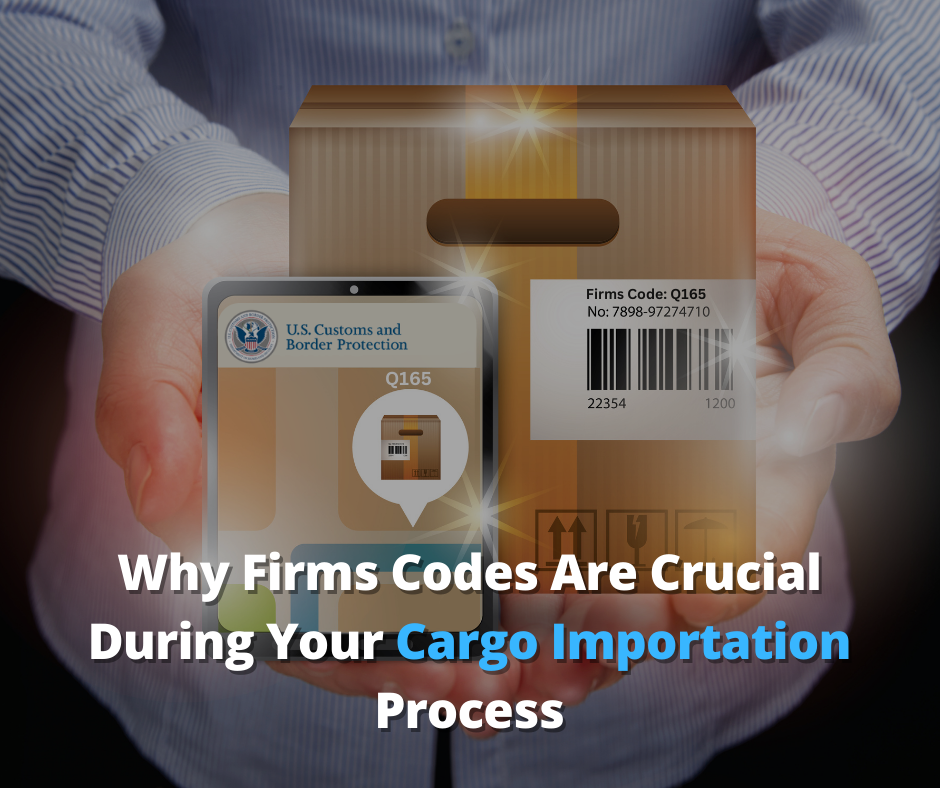
A guide for business and customers
When running a cargo importation process, it is of the essence to understand and utilize firm codes. Otherwise, logistical problems can turn this into an unnecessarily tedious process. As a starting point, it helps if one has a clear understanding of what firm codes are and their roles in this business. Some literature discusses the Facilities Information and Resources Management System (FIRMS). These are codes that comprise a quartet of digits. These digits are unique identifiers that include alphabetical letters as well as numbers.
The assignment process for the firm codes
The institution responsible for assigning the codes is the United States Customs and Border Protection (CBP), which is tasked with managing customs and bonded facilities that manage the goods as they arrive. By reading the alpha-numeric code, it is possible to identify the exact location of the cargo imported into the USA. These codes are assigned to different customs bonded facilities. Such facilities may include warehouse de-consolidators, freight stations, bonded warehouses, and foreign trade zones.
It is anticipated that all qualifying facilities will be secured. The security is meant to ensure that access to dutiable imported goods is only allowed after proper authorization. This authorization will only occur when all duties and taxes have been paid. However, safeguards prevent consignments from being manipulated to avoid taxes or other oversight. There have been cases where imports have undergone manufacturing operations before paying the requisite duties. That is why the allocation of these firm codes is taken very seriously. Violations can lead to severe penalties, including imprisonment.
Facilities that are curated and coded for regulatory purposes
The FIRMS code is akin to a tracking device for the facilities. The code is only offered and approved after a location has filed its status with the CBP. The CBP bond is acquired through accessing the Bond Centralization Program, which can be done only at the CBP.gov website, with the requisite information found on the Trade Tab. The user then drills down to the “Programs and Administration” section before clicking on the “Bonds” option. It is not considered appropriate to manage imports subject to duty when not registered with the authorities and given a code.
The facilities that have acquired a FIRMS code will be on the Automated Manifest System (AMS) and bonded accordingly. An alternative access point is the Automated Commercial Environment (ACE). Being on either of these platforms makes it easier to transfer and process goods crossing borders. Indeed, business partners may be concerned if the service provider has not been appropriately registered. This is because the failure to engage in due diligence can lead to sanctions that significantly add to the business costs. The customs and excise authorities also ensure compliance through regular inspections, monitoring, and evaluation.
Optimizing the use of FIRMS codes
Using FIRM codes is not only a legal requirement but is also critical for smoothening the process of logistics management. For example, these codes enable the entry process to be completed without too many bureaucratic hurdles. They are also crucial for tracking bonded goods, so they do not escape the process. These codes are the form of communication with the US Customs Port of Entry, an important regulator that can determine the pace and success of these transactions. Indeed, FIRMS codes are a necessity when completing critical importation paperwork.
These codes are also critical for processing in-bond transit orders. For example, they are an accompaniment for other customs and excise documentation. Foreign arrivals may be rejected or refused entry if there is no FIRMS code designation quoted. Many ports of entry operate using an electronic process. Without FIRM codes, this becomes cumbersome and even impossible in some instances. The ease of doing business in this sector is greatly enhanced with a good understanding and use of FIRMS codes. Many professionals operating the sector rely on them for their own work.
Use of FIRMS codes by brokers and customers
Because the FIRMS codes are used to precisely indicate the current location, they are a necessary instrumentality for brokers. Bonded shipments can be numerous and may involve complex transactions. Without appropriate coding, there is an elevated risk of losses and mistakes being made. The costs of resolving those mistakes make a strong business case for investing in learning about these codes and fully integrating them into the importation business. In addition, the inspectors often ask for locations, and these codes will make that process more effective.
The goods subject to these codes and locations are better protected using FIRMS codes. For example, warehouses will be aware of the location of shipments regardless of their diversity and number. The codes assist in protecting goods, making it easier for warehouses to keep track of the shipments. They also make it possible for CBD to notify the warehouse once the cargo has been cleared for duty and taxes. By holding everyone involved accountable, the FIRMS codes improve performance and service delivery. The freight movement becomes a more stable and predictable exercise as opposed to the alternative of each unit developing its tracking mechanism.
Maintaining an update list of codes for day-to-day reference
The dynamism of shipping means that the list of codes needs to be regularly updated. Therefore, it is good practice to watch the existing databases so that any updates are duly recognized and acted upon. CPB is immensely helpful in this respect because it provides an extended list of FIRMS codes that are accessible. It is best to contact the facility if the code is unclear. Some goods are stored centrally if they are pending clearance and there are no suitable alternatives. The codes can help to untangle any confusion about their location.
Wrapping up
The critical side of shipping is a complex business that requires tools that make the process easier for customers and service providers. One of those instruments is the FIRMS codes which track the exact location of cargo as it awaits clearance following the payment of any taxes or duties. Businesses that import merchandise or support this process must be conversant with these unique codes to better contribute to the smooth running of the supply chain.




